If you’ve translated your passion for cooking, baking, or even just eating into a blog, congratulations! You’re sharing what you love with the world and building an audience along the way. If there’s one thing all bloggers know, it’s that maintaining a blog – keeping it updated with relevant, fun content – is a lot of work.
For most, it’s a labor of love – but wouldn’t it be nice if you could make money off your blog at the same time?
In this article, I’ll explore a bunch of ways you can earn cash while doing what you love: creating engaging, fun, educational content for your food blog.
If you’re just getting started on your blogging journey, you can check out my beginner’s guide for how to start a blog.
But if you already have a blog up and running, this article will explain how you can start earning money from your food blog.
How to Make a Food Blog Profitable

If you’ve already got your food blog up and running, this guide will give you all the tips and tricks you need to monetize your blog and start earning an income from all your hard work.
1. Ad Revenue
Ad revenue is the first and most common way most bloggers monetize their blogs.
Chances are, you’ve seen these before – in fact, they’re pretty much impossible to avoid! They’re the little square ads that come up at the bottom of a web page or blog post or that float around on the sides of the page as you’re scrolling.
These ads are a major source of revenue for bloggers and website creators, and you can use them to monetize your blog, too.
Google Adsense is the most popular and commonly-used ad placement tool, but there are some better alternatives to Google Adsense on the market as well, such as Ezoic, Mediavine, and Adthrive, all of which offer ad placement that’s relevant to your specific niche.
These tools essentially work by placing ads on your site, which then generate revenue for you either based on viewers engaging with them (i.e., clicking on them) or simply by viewing them.
Of course, the ad placement tool you’ve chosen will take a cut of the profit as well.
2. Sponsored Content
Another very popular way for bloggers to earn money is through sponsored content.
Sponsored content is a form of advertising where companies pay you to promote their product or brand on your blog.
Sponsored content has become one of the most profitable forms of advertising, with revenue from social media sites like Instagram increasing every year.
This means that brands are keen to get their products in the hands of bloggers, influencers, and anyone else with a strong following.
For food blogging, sponsored content is often paired with recipe development, food/product development, and social media boosting.
Popular sponsored content for food bloggers includes:
- Kitchenware, serveware, and other cooking tools
- Food and ingredient brands (who may ask you to prepare a recipe featuring one of their products as an ingredient)
- And even companies that are adjacent to the food industry, such as nutritional supplement brands or camera companies.
Keep in mind that, in order to attract brands willing to pay you to advertise their products, your blog needs to already have a fairly large audience.
This means that earning money through sponsored content isn’t really a viable option for food blogging newcomers or blogs that haven’t yet connected with a larger audience.
If you’re still in the early stages of growing your blog’s content and viewers, then using an ad placement tool like Google Adsense is a more realistic way to earn money from your blog.
3. Affiliate Marketing
Affiliate marketing is one of the most lucrative ways to monetize blogs, and it’s somewhat similar to sponsored content.
With affiliate marketing, you work with Amazon or another shopping service to create affiliate links that you include in relevant blog posts.
For example, let’s say you regularly use a particular blender or a special brand of gluten-free flour in your cooking adventures.
If you’ve made a deal with Amazon or another seller that stocks this particular product, you can include an affiliate link to it in your blog posts.
When someone clicks on the link, they’ll be directed to buy that item from the website you have an affiliate deal with, thus earning you a small amount of money and putting a product you genuinely trust into the hands of your followers.
Just remember that it’s important to be transparent and disclose when your posts include affiliate links. As an example, see this site’s affiliate disclosure here.
4. Teach What You Know
Chances are you’ve learned a lot in the process of creating evergreen content for your food blog, so why not earn some extra income from sharing your knowledge?
Many food bloggers offer classes to their followers. These are usually virtual but could also be in-person, depending on your geographical location.
Depending on your specialty, you could offer cooking classes, food photography classes, or even classes on how to create a successful food blog!
5. Write a Cookbook
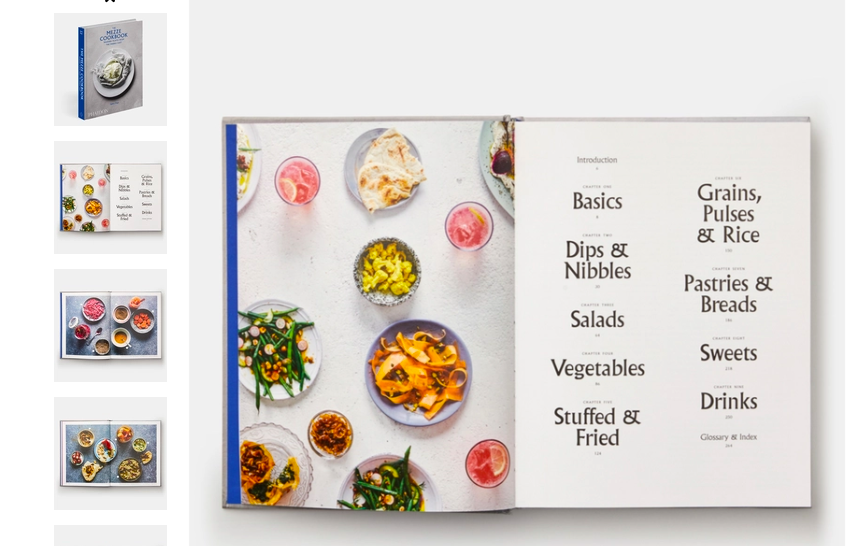
If you’ve been blogging for a while and developing your own recipes, it might be time to take the next big step and write your own cookbook.
This is a dream for many food bloggers, and if you have a large enough audience, writing your own cookbook can turn your blog into a fully-realized culinary career.
Although you can opt to look for an agent and/or publishing house to publish physical copies of your book, many food bloggers also opt to self-publish their eBooks on Amazon.
This allows you to cut down on costs while marketing your book on your blog and can help you majorly increase your audience and your revenue.
6. Sell Your Services as a Food Photographer (Or Sell Your Photos)

If you spend enough time poking around the food blogosphere, you’ll probably notice that a fair number of food bloggers also have food-adjacent careers, such as recipe development and/or food photography.
If photography is a talent of yours, you can sell your services as a food photographer in addition to using your skills to enhance your own blog.
You can even use your blog as a portfolio of your work to show to potential clients, who may be cookbook developers, cooking website editors, marketing teams, or even other food bloggers.
Food photography can be a lucrative and rewarding career or side hustle if you have the talent and the right equipment.
Additionally, many food bloggers don’t realize that you can sell your photos online, either to stock photo companies or other websites, and earn a profit.
Buyers will pay a flat fee for your photos (based on the size of the digital file), and this way, you can earn money from work that you’ve already done for your blog. Easy peasy!
7. Create A Patreon
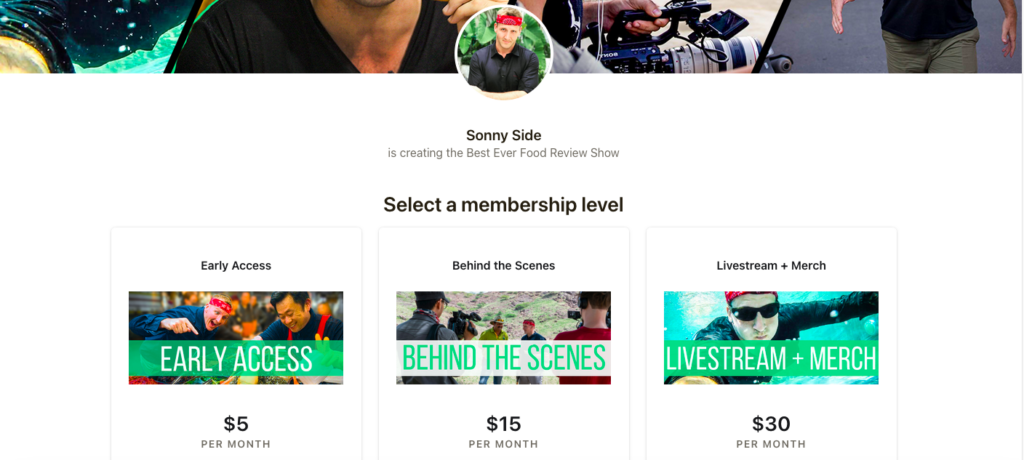
If your blog has a big following – particularly if you’re active on YouTube or another video sharing/vlogging site – you can ask your fans to support you directly through Patreon.
Most content creators on Patreon offer a few different membership tiers, each of which comes with different perks.
For example, these could include early access to new content, a personalized shout-out in a video or blog post, a one-on-one virtual cooking class, or a discount on merchandise like cookbooks.
Although Patreon isn’t generally the biggest source of income for food bloggers, the key to making a profit as a blogger is diversifying your revenue stream, and Patreon is a great way to earn a little extra by allowing your fans and followers to support your work directly.
How to Make Money as a Food Blogger on Instagram

If you’re wondering how to make a living as a food blogger, having active social media accounts is one of the main keys to success.
For food blogging, Pinterest and Instagram are by far the most important (and potentially lucrative!) social media sites, so make sure you put in the effort to build your following base and keep your content updated on these sites.
Pro tip: to ensure that your Instagram posts reach their maximum engagement, use as many relevant hashtags as possible.
Successful food influencers can have hundreds of thousands of followers and generally earn their income from brand partnerships and sponsored ads.
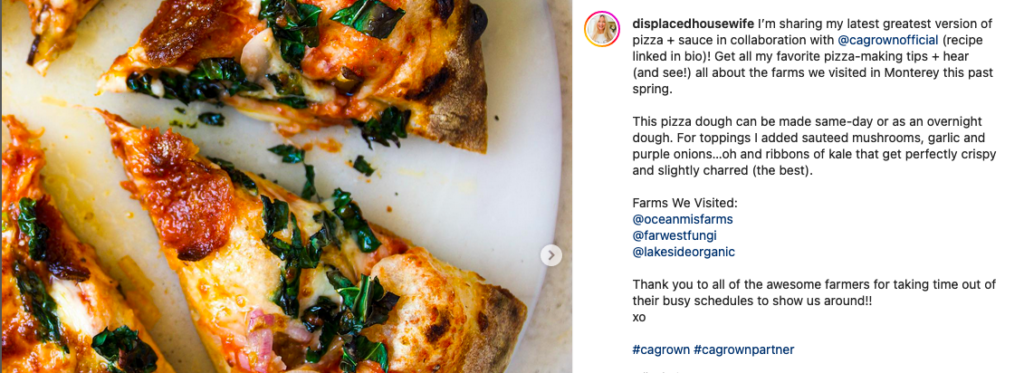
Cookware, kitchenware, and other food-related brands will pay a lot to get their products into the hands (and posts) of popular foodgrammers, many of whom earn five figures or more per month simply from posting branded and sponsored content.
If you’re not sure where to start, follow as many food blogging and culinary-related accounts as possible, and take a look at how they post and market their sponsorships and brand partners.
In addition to branding partnerships and sponsored content, you can use your Insta to link to your blog and any products you may be selling, such as your cookbook or your line of cooking products.
In short, the key is to create a holistic, entwined relationship between your blog and your social media accounts, thus driving traffic between your different content sources and increasing the likelihood of earning profit from all of them.
Inspiration: Most Profitable Food Blogs in 2025
So, how much money exactly can you make as a food blogger in 2025? Can you make a living as a food blogger?
It is absolutely possible to earn a living as a food blogger: in fact, many people do.
However, it’s difficult to generalize exactly how much money you can expect to make in a year as a food blogger since it varies depending on a ton of factors such as your niche, your geographical region and language, how much time and effort you put in, and – as always – luck.
Although many food bloggers never attempt to monetize their work, others have earned some serious cash, and many have gone on to publish cookbooks, teach cooking classes, and even star in cooking shows.
If you’re looking for inspiration, it’s always a good idea to check out what others have done right. So, let’s take a look at a few of the most popular (and profitable!) food blogs on the web today.
1. Pinch of Yum
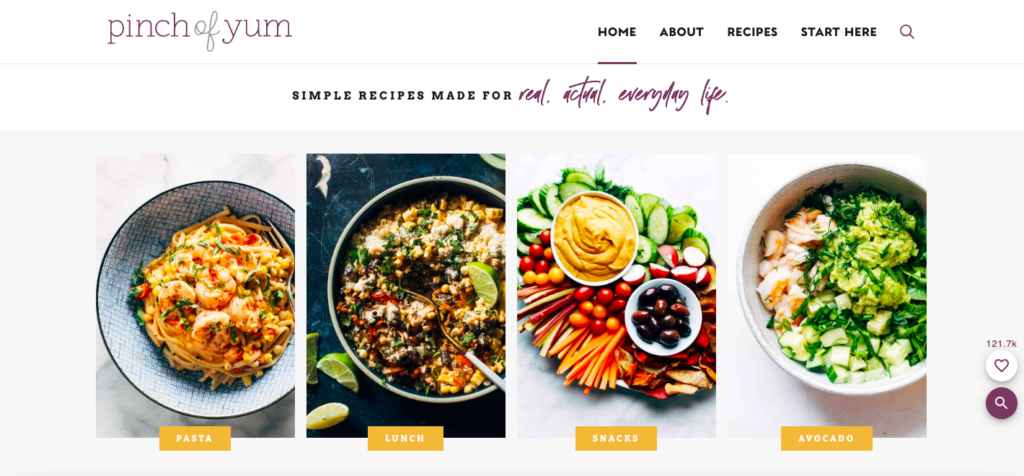
One of the most beloved food blogs on the internet is Pinch of Yum, which was started all the way back in 2010 by wife-and-husband duo Lindsay and Bjork.
One of the unique features of Pinch of Yum is its monthly traffic and income reports, in which the audience can follow how much money Pinch of Yum earned every month from 2011 to 2016 (the income reports were then discontinued in 2017).
Over those six years, Pinch of Yum went from earning a mere $21.97 in 2011 a month to an insane $96,000 in November 2017.
The income reports also helpfully break down the different sources of income. The vast majority of Pinch of Yum’s profit comes from ad revenue and sponsored content, with a decent amount earned in Amazon affiliate links and eBook sales as well.
In addition to all the great food-related content, Lindsay also regularly blogs about topics such as travel, blogging as a business, and the joys and challenges of motherhood.
Bjork has started an online community for anyone looking to start their own food blog called Food Blogger Pro, which offers tutorial videos and resources.
2. Love & Lemons
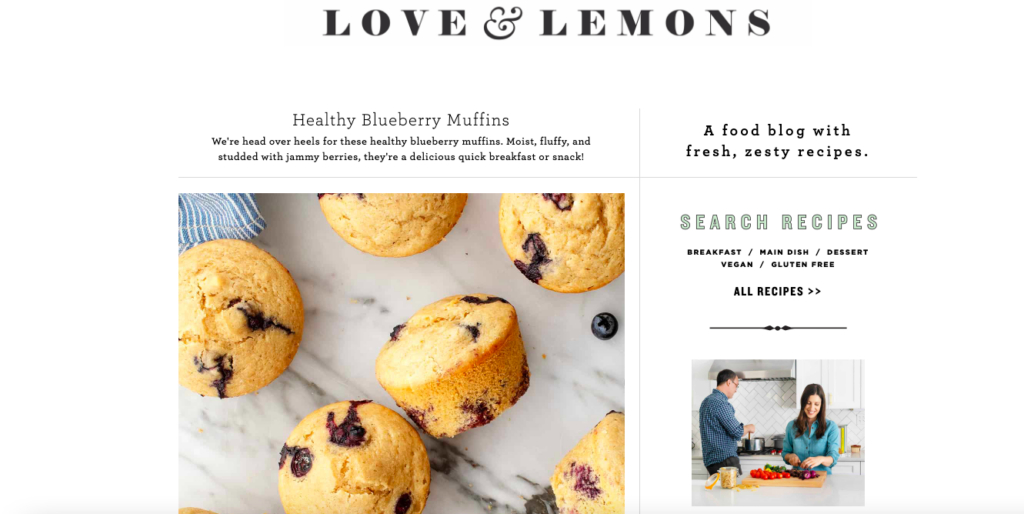
Love & Lemons is a wildly popular food blog focusing on healthy, “veggie-centric” recipes that are easy to make at home.
Love & Lemons blog creator Jeanine Donofrio has published two successful vegetarian cookbooks since starting her blog.
In addition to revenue from her blog, books, and social media accounts, she also partners with and develops recipes for major brands such as Le Creuset, Anthropologie, Whole Foods, KitchenAid, and others.
3. Minimalist Baker
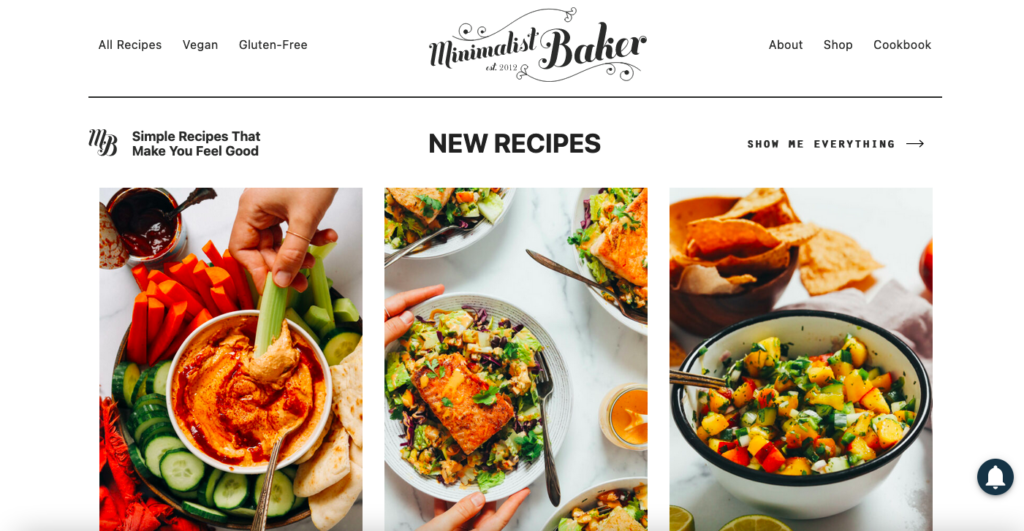
At Minimalist Baker, simplicity is the name of the game: creator Dana Schultz promises that all recipes she creates and features on her blog either “require 10 ingredients or less, 1 bowl, or 30 minutes or less to prepare.”
There is a highly successful Minimalist Baker cookbook that accompanies the blog, as well as a beautifully-designed online shop featuring a wide range of affiliated links.
Schultz also partners with a variety of brands and works as a food photographer.
Minimalist Baker was founded in 2012, and Schultz now earns a whopping $4 million a year from her food blogging empire, making her one of the most successful creators in the field.
4. Smitten Kitchen
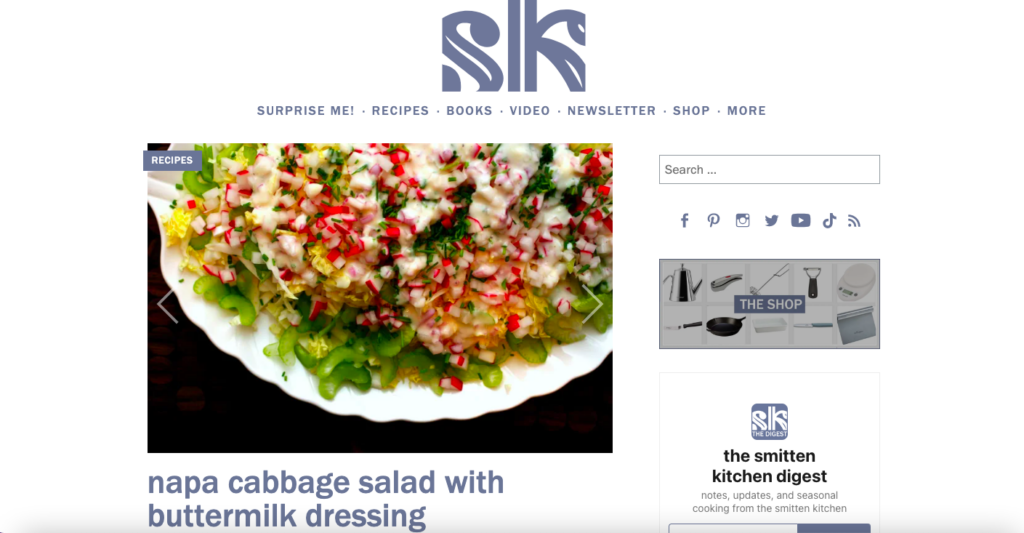
With an adorable name and a sleek, eye-catching website, Smitten Kitchen creator Deb Perelman focuses on elevated comfort-food recipes and cooking tutorials.
Smitten Kitchen also features a store with affiliate-linked products, and Perelman has published no fewer than three original cookbooks.
The Smitten Kitchen’s Instagram account has 1.6 million followers, and Perelman’s efforts have earned her an estimated $1-5 million dollars.
5. Cookie & Kate
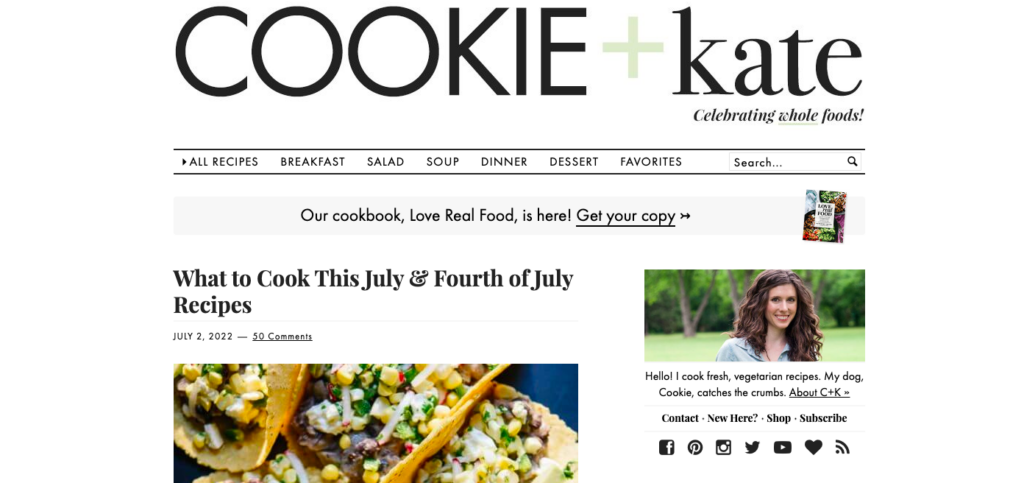
Although this blog sounds like it could be the creation of two sisters or friends, the sole human creator is Kate (Cookie is her dog or her “canine sidekick”).
Cookie & Kate is a fantastic source for plant-based recipes for all meals and occasions, as well as cooking tips and advice about how to start your own food blog.
In addition to – you guessed it – her signature cookbook, Kate earns commissions through her Amazon shop, which includes recommended products ranging from kitchen appliances to dog toys.
She is also very active across an impressive number of social media channels, including YouTube, Twitter, and Facebook.
6. The First Mess

If you’re looking for inspiration in the vegan cooking niche, one of the most popular vegan food blogs is The First Mess.
The blog’s creator, the Ontario-based chef Laura Wright, has also written and published a successful cookbook (sold in both paper and ebook form) dedicated to making healthy, delicious, seasonal vegan cooking as easy and fun as possible.
She’s also built her blog’s reputation and popularity by producing recipes for a number of well-known publications, including Bon Appetit, The Kitchn, Food Network, and the Washington Post.
The Bottom Line: How to Earn Money From Your Food Blog
There’s no single recipe for success when it comes to food blogging, but there are several key ingredients that can make a huge difference in your profits (puns intended).
If you have an active, polished blog that you’re ready to take to the next level, the first step is to sign up with a targeted ad placement tool and start earning revenue from ads on your site.
Next, you can approach the brands you know and love about sponsored content deals and work with Amazon or another online retailer to put affiliate links on your site.
You can also earn money from your expertise by publishing a cookbook of your original recipes or selling your beautiful food photography and/or services as a photographer.
If you have a knack for teaching, you can offer classes in cooking and/or food photography and earn money in one of the most rewarding ways.
This is your path to walk, and having a unique approach is what will make you stand out from the pack.
However, it’s important to also take the time to explore what other successful food bloggers have done, where they have succeeded, and what (in your opinion) they could be doing better.
Market research is an invaluable part of any business plan, and you have to know the competition to get ahead!
All in all, creating an engaging food blog that offers something unique and valuable to your audience is a labor of love, and with hard work, creativity, and patience, you can turn it into a lucrative side gig or even a full-time career.
References
- Tartine Gourmande Instagram account – https://www.instagram.com/tartinegourmande/
- Patreon – Best Ever Food Review Show – https://www.patreon.com/BestEverFoodReviewShow
- Hidden Rhythm – https://www.hiddenrhythm.com/episodes/65
- Phaidon cookbook – https://www.phaidon.com/store/food-cook/the-mezze-cookbook-9780714876856/
- Displacedhousewife Instagram – https://www.instagram.com/p/Cfy5BsxL2EH/
- Love & Lemons – https://www.loveandlemons.com/
- Minimalist Baker – https://minimalistbaker.com/
- Smitten Kitchen – https://smittenkitchen.com/
- Cookie & Kate – https://cookieandkate.com/
- The First Mess – https://thefirstmess.com/
- Pinch of Yum – https://pinchofyum.com/
